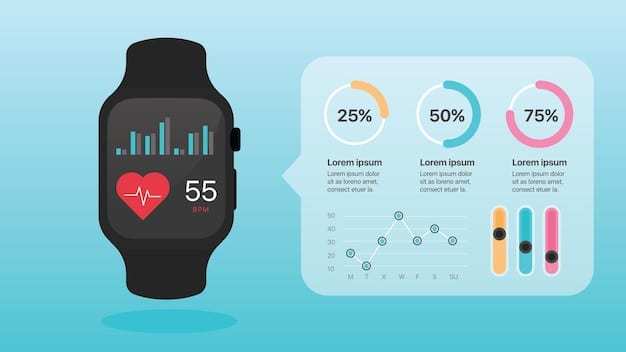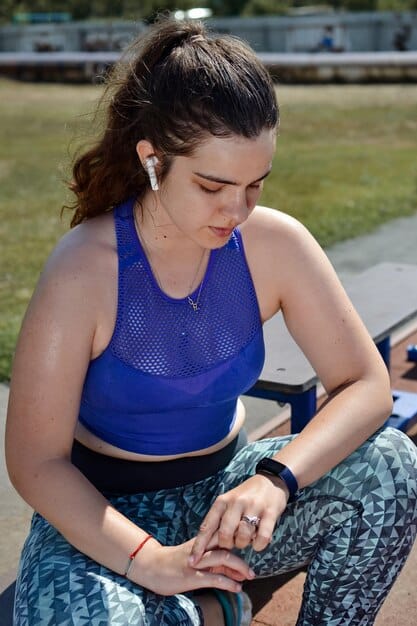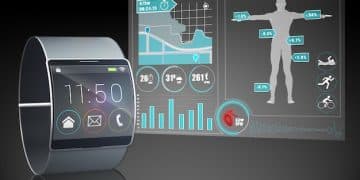Smartwatch Face-Off: Best Health Tracking $400 Models in 2025

Looking for the best health tracking smartwatch under $400 in 2025 involves comparing various models’ sensor accuracy, advanced health features like continuous glucose monitoring, and comprehensive data integration crucial for informed well-being management.
In 2025, the market for affordable smartwatches with robust health tracking capabilities has truly matured. This Smartwatch Face-Off: Which $400 Model Offers the Best Health Tracking in 2025? will cut through the noise, guiding you toward devices that offer exceptional health insights without breaking the bank.
The Evolving Landscape of Smartwatch Health Tracking in 2025
The year 2025 marks a pivotal moment in wearable technology, particularly for smartwatches positioned within the accessible $400 price point. These aren’t just notification hubs anymore; they’ve become sophisticated personal health companions, integrating an array of sensors and algorithms that were once exclusive to far more expensive medical-grade devices. The focus has decisively shifted from mere step counting to comprehensive physiological monitoring, offering users an unprecedented window into their well-being.
This evolution is driven by advancements in miniaturized sensor technology, improved battery efficiencies, and the burgeoning field of artificial intelligence within consumer electronics. What was once aspirational, like accurate sleep stage detection or stress monitoring, is now standard even in mid-range models. The competitive landscape means manufacturers are constantly pushing the boundaries, offering features that genuinely empower users to take proactive steps in managing their health.
Key Technological Leaps
Several technological breakthroughs have underpinned this transformation. New optical heart rate sensors are more accurate than ever, even during intense workouts. Bio-impedance sensors, previously found only in dedicated body composition scales, are now integrated into wrist-worn devices, offering insights into body fat and muscle mass. The continuous refinement of algorithms also plays a crucial role, translating raw sensor data into meaningful, actionable health insights.
- Enhanced Sensor Accuracy: Advances in optical heart rate and SpO2 sensors provide more reliable readings.
- Advanced Biometric Integration: Beyond heart rate, many devices now incorporate EDA (electrodermal activity) for stress or skin temperature sensors.
- AI-Powered Insights: Machine learning algorithms interpret complex data patterns, providing personalized health recommendations.
- Longer Battery Life: Optimized power management allows for continuous tracking over several days, minimizing चार्जing interruptions.
The increasing reliability and breadth of data collected by these devices mean they’re not just gadgets, but tools. They empower users to understand their bodies better, identify potential health patterns, and even share data with healthcare providers, fostering a more connected approach to personal wellness. The sub-$400 category specifically benefits from this trickle-down effect, as premium features rapidly become democratized.
Core Health Metrics: Beyond the Basics
When evaluating smartwatches for health tracking, it’s essential to look beyond the basic step count and calorie burn. In 2025, a truly capable health smartwatch, even at a $400 price point, offers a robust suite of advanced metrics. These core metrics provide a holistic view of your physiological state, moving from mere activity logging to genuine health monitoring that can inform lifestyle choices and alert you to potential issues.
The accuracy and reliability of these readings are paramount. While consumer wearables are not medical devices unless specifically FDA-cleared, their trends and insights can be incredibly valuable for personal awareness. Manufacturers have invested heavily in refining their sensors and algorithms to deliver data that is as close to medical-grade as possible within a consumer context.
Heart Health Monitoring
This is arguably one of the most critical functions. Beyond resting heart rate, look for continuous heart rate monitoring throughout the day and during exercise. Features like high and low heart rate alerts, and irregularity notifications for potential atrial fibrillation (AFib), are becoming increasingly common and valuable. Some models even offer on-demand ECG (electrocardiogram) capabilities, providing a snapshot of your heart’s electrical activity. This proactive monitoring can offer early warning signs that warrant professional medical attention.
Sleep Tracking, Advanced Stress, and Recovery Metrics
- Comprehensive Sleep Stages: Distinguishing between light, deep, and REM sleep, with insights into sleep quality.
- SpO2 (Blood Oxygen Saturation): Monitoring blood oxygen levels, especially overnight, can indicate potential respiratory issues.
- Advanced Stress Management: Using heart rate variability (HRV) and electrodermal activity (EDA) sensors to quantify stress levels.
- Recovery Metrics: Calculating a “Readiness Score” based on sleep, activity, and HRV to suggest optimal training or rest days.
These metrics, when combined, paint a detailed picture of your body’s response to daily life and exercise. Understanding your stress patterns or recognizing days when your body needs more rest can significantly impact overall well-being and performance. The ability of a smartwatch to not only collect this data but also to present it in an understandable, actionable way is a key differentiator in 2025.

Contenders Under $400: Who’s Leading the Pack?
In 2025, the under $400 smartwatch segment is fiercely competitive, with several manufacturers vying for supremacy in health tracking. While specific model names can shift, the key players generally include refreshed versions of popular lines from Fitbit, Garmin, Samsung, and some emerging brands leveraging advanced sensor tech. Each brings a slightly different philosophy to health monitoring, catering to various user needs and preferences.
When considering these contenders, it’s not just about the number of features, but also the quality and reliability of the data, the intuitiveness of the accompanying app, and the overall user experience. The best health tracking smartwatch for you will depend on your specific priorities, whether it’s granular sleep analysis, robust fitness tracking, or comprehensive stress management.
Fitbit (e.g., Sense 3 / Versa 5 equivalent)
Fitbit continues to be a strong contender, leveraging its long-standing expertise in holistic health tracking. Their models typically excel in sleep analysis, stress management (often with EDA sensors), and comprehensive activity tracking. The accompanying Fitbit app is renowned for its user-friendliness and actionable insights, often providing personalized guidance. For those invested in mindfulness and stress reduction, Fitbit remains a top choice.
Garmin (e.g., Venu Sq 3 / Forerunner 55 equivalent)
Garmin, traditionally known for its sports and outdoor watches, has significantly expanded its health features. Their offerings in this price range often emphasize precise GPS tracking, advanced training metrics, and comprehensive body battery monitoring. For active individuals who want detailed performance data alongside general health tracking, Garmin presents a compelling package. Their sleep tracking and pulse ox capabilities are also robust.
Samsung (e.g., Galaxy Watch 7 (non-Pro) equivalent)
Samsung’s contributions typically blend cutting-edge technology with seamless integration into their broader ecosystem. Their smartwatches often feature bioelectrical impedance analysis (BIA) for body composition, advanced ECG, and robust blood pressure monitoring (in regions where approved). For Android users, particularly those with Samsung phones, the synergy and feature set can be very appealing, offering a comprehensive health hub.
Emerging Brands and Specialized Trackers
Beyond the major players, several innovative brands are making significant strides. Some specialize in specific areas, like continuous glucose monitoring (CGM) integration (though full, non-invasive CGM is rare at this price in 2025), or offer unique form factors focused purely on health data (e.g., smart rings). While these might lack the broad app ecosystem of larger brands, their niche focus or unique sensor capabilities can be a game-changer for specific users. Always research the longevity and support for these newer entrants.
Ultimately, the best model will depend on what health metrics you prioritize, your existing smartphone ecosystem, and whether you value breadth of features or depth in specific areas. Testing the accompanying apps and reading detailed reviews focused on sensor accuracy is crucial before making a final decision.
Advanced Health Features Under $400: What to Expect
The “advanced” health features available in a sub-$400 smartwatch in 2025 have evolved significantly, pushing the boundaries of what consumers can expect from an accessible wearable. These are the differentiating factors that elevate a solid health tracker to a truly insightful personal health companion. Gone are the days when advanced meant just heart rate; now, it encompasses a suite of sophisticated measurements and analytical capabilities.
Understanding which advanced features are genuinely impactful and accurate is key to making an informed choice. While some are still in their infancy for widespread consumer adoption (like non-invasive glucose monitoring), others have matured to offer reliable, actionable data for general wellness.
Electrocardiogram (ECG) and Atrial Fibrillation (AFib) Detection
Many smartwatches in this price range now offer on-demand ECG capabilities, providing a single-lead electrocardiogram reading that can detect signs of atrial fibrillation, a common form of irregular heart rhythm. While not a diagnostic tool, it can be a crucial early warning system, prompting users to seek medical advice. This feature has proven its worth in real-world scenarios, making it a highly desirable inclusion for heart health monitoring.
Skin Temperature Tracking and Cycle Predictability
- Baseline Skin Temperature: Monitoring nightly skin temperature variations can indicate illness, stress, or even ovulation in women.
- Advanced Cycle Tracking: Integrating skin temperature and other biometric data for more accurate prediction of ovulation and menstrual phases, aiding in family planning or general health awareness.
These features offer valuable insights into the body’s internal state beyond just activity. Skin temperature trends can be an early indicator of fever or even track changes related to environmental factors. For women, enhanced cycle tracking often provides a more personalized and precise understanding of their reproductive health, moving beyond simple calendar-based predictions.

Blood Oxygen (SpO2) and Respiratory Health
The ability to measure blood oxygen saturation (SpO2) has become a standard advanced feature. While primarily beneficial for detecting sleep-disordered breathing, it also provides general wellness insights. Consistent low SpO2 levels can be an indication of underlying respiratory issues or altitude sickness. The accuracy of SpO2 sensors has improved dramatically, making them a reliable metric for personal health monitoring.
Stress Monitoring and Recovery Metrics (HRV, EDA)
Beyond simple stress scores, advanced smartwatches often use Heart Rate Variability (HRV) and Electrodermal Activity (EDA) sensors to provide a deeper understanding of the body’s stress response and recovery state. High HRV generally indicates better adaptability to stress, while EDA sensors detect tiny changes in electrical conductivity of the skin, correlated with sympathetic nervous system activity (stress). These metrics can help users identify stressors, practice mindfulness, and optimize their rest and training. Some devices even offer guided breathing exercises or “body battery” scores to indicate mental and physical readiness.
While consumer-grade, these advanced features offer a powerful toolset for self-awareness and proactive health management. When choosing, prioritize features that align with your personal health goals and lifestyle, and always cross-reference device claims with independent reviews regarding accuracy.
User Experience, App Ecosystem, and Data Integration
Beyond the sheer number of sensors and features, the actual value of a smartwatch’s health tracking capabilities hinges significantly on its user experience, the quality of its accompanying app ecosystem, and how seamlessly it integrates data. A device might collect vast amounts of data, but if it’s presented in an incomprehensible way or confined to a clunky interface, its utility diminishes rapidly. In 2025, a great health tracking smartwatch offers intuitive interaction and actionable insights.
The companion app is arguably as important as the watch itself. It’s where raw data transforms into meaningful trends, where personalized advice is delivered, and where you can delve deeper into your health metrics. A good app should be easy to navigate, visually appealing, and provide clear explanations of what your data means for your health.
Intuitive Interface and Readability
A smartwatch, especially one used for quick health checks, needs a clear, responsive interface. This includes customizable watch faces that can display key health metrics at a glance, easy navigation through menus to access specific measurements, and vibrant, legible displays in various lighting conditions. For health, being able to quickly check your heart rate or start an ECG without fumbling through menus is crucial.
The Power of the Companion App
Think of the companion app as your personal health dashboard. It should aggregate all your collected data—sleep, heart rate, activity, stress, etc.—into coherent trends and summaries. Look for apps that:
- Offer Personalized Coaching: Based on your data, suggest optimal activity levels, recovery times, or strategies to reduce stress.
- Provide Historical Trends: Allow you to view your health data over days, weeks, months, or even years, identifying long-term patterns.
- Present Actionable Insights: Translate complex data into simple, understandable takeaways, such as “Your sleep quality improved by 15% this week” or “Consider a rest day based on your recovery score.”
- Allow Data Export: For sharing with healthcare providers, though this might require manual export or specific integrations.
The app should empower you, not overwhelm you, with data. The best apps guide you toward better health decisions rather than just logging numbers.
Seamless Data Integration with Third-Party Platforms
For many users, a smartwatch isn’t an isolated device. It’s part of a broader digital health ecosystem. The ability to sync your health data with other fitness apps (e.g., Strava, MyFitnessPal) or health platforms (e.g., Apple Health, Google Fit) is highly beneficial. This integration prevents data silos, allowing for a more comprehensive view of your health and fitness journey across multiple devices and services. Check if the smartwatch you’re considering offers robust API support or direct integrations with apps you already use.
Ultimately, a smartwatch that excels in user experience, offers a powerful and intuitive app, and integrates well with other platforms provides a far more valuable and sustainable health tracking experience, ensuring you stay engaged with your data and committed to your wellness goals.
Accuracy, Reliability, and Limitations of Smartwatch Health Data
When delving into health tracking with smartwatches, especially those in the $400 range, it’s paramount to establish a realistic understanding of accuracy, reliability, and inherent limitations. While these devices have made incredible strides in their capabilities, they are primarily consumer wellness tools, not medical diagnostics, unless explicitly stated and FDA-cleared for particular functions. Users should view the data they provide as valuable insights and trends, rather than definitive clinical measurements.
The technology behind these sensors—chiefly photoplethysmography (PPG) for heart rate and SpO2, and bio-impedance for body composition—is sophisticated but can be influenced by various external factors. Understanding these nuances helps in interpreting the data judiciously and knowing when to consult a medical professional.
Factors Influencing Sensor Accuracy
Several variables can affect the precision of smartwatch health sensors. Skin tone, tattoos, hairy arms, movement artifacts during activities, and even ambient temperature can all subtly alter readings. For instance, optical heart rate sensors perform best when worn snugly and consistently, but vigorous exercise can introduce movement that makes accurate readings challenging. Similarly, SpO2 readings can be affected by poor blood circulation in the wrist or device placement.
Trends vs. Clinical Diagnosis
- Valuable for Trends: Smartwatch data is excellent for observing personal baselines and identifying shifts or emerging patterns over time (e.g., a consistent increase in resting heart rate, changes in sleep quality).
- Not for Self-Diagnosis: It’s critical never to use smartwatch data for self-diagnosis or to replace professional medical advice. Anomalies detected by the watch should prompt a conversation with a doctor, not self-treatment.
- FDA Clearance and Medical Features: Certain features, like ECG for AFib detection, may receive FDA clearance, allowing them to be considered medical devices for that specific function. Always verify the regulatory status of specific features if diagnostic capability is important to you.
Manufacturers are transparent about these limitations, and the disclaimers often accompany their products. However, the user’s responsibility lies in understanding these boundaries and using the technology wisely. The goal is empowerment through information, not to bypass clinical care.
Battery Life and Data Continuity
Another often overlooked aspect of reliability is battery life. A smartwatch that constantly needs charging impacts data continuity, leading to gaps in long-term health trends, especially for overnight monitoring of sleep and SpO2. Models offering multi-day battery life (at least 3-5 days with all sensors active) are superior for consistent data collection and deeper insights into recovery and sleep patterns. A device that’s frequently off your wrist due to low battery is simply not collecting the full picture.
Ultimately, smartwatches in the $400 range offer remarkably sophisticated health tracking, providing valuable tools for self-awareness and proactive wellness management. However, appreciating their role as complementary components to traditional healthcare, rather than substitutes, is key to leveraging their full potential responsibly.
| Key Metric | Brief Description |
|---|---|
| ❤️ Heart Health | Includes continuous HR, ECG, and AFib alerts for comprehensive cardiac monitoring. |
| 😴 Sleep & Recovery | Advanced sleep stages, SpO2, and HRV for stress and recovery insights. |
| 📊 Data Ecosystem | Crucial for app integration, user-friendly data presentation, and third-party sync. |
| ⚙️ Feature Balance | The best watch balances sensor accuracy, advanced features, and seamless user experience. |
Frequently Asked Questions
▼
Yes, smartwatches in this price range in 2025 offer remarkable accuracy for general wellness tracking. While not medical devices, their improved optical sensors and refined algorithms provide highly reliable data for heart rate, blood oxygen, sleep patterns, and activity. Always consider them tools for insight and trend monitoring rather than precise clinical diagnostics.
▼
Prioritize features like ECG for AFib detection, comprehensive sleep stages with SpO2 monitoring, and advanced stress tracking (HRV, EDA). These offer the most impactful insights into cardiovascular health, respiratory wellness, and mental well-being, moving beyond basic activity metrics. Look for devices that provide actionable insights from this data.
▼
The companion app is critically important. It’s where your raw data transforms into meaningful trends and personalized insights. A good app should be user-friendly, provide clear explanations of your metrics, offer historical data views, and ideally integrate with other health platforms. A poor app can significantly diminish the value of even the most feature-rich smartwatch.
▼
Absolutely not. Smartwatches are designed for general wellness and fitness purposes, offering valuable data for personal awareness. They are not substitutes for professional medical diagnosis or treatment. Any concerning readings or symptoms should always prompt a consultation with a qualified healthcare provider. Use your smartwatch as a tool for informed discussions with your doctor.
▼
While non-invasive CGM is a highly anticipated feature, widespread, truly accurate integration into smartwatches, especially under $400, remains a significant technological hurdle in 2025. Current devices might offer estimations or integration with external CGM devices, but self-contained, reliable non-invasive CGM is likely still a few years away from consumer-grade wearables at this price point.
Conclusion
Navigating the “Smartwatch Face-Off: Which $400 Model Offers the Best Health Tracking in 2025?” reveals that consumers no longer need to compromise on advanced health monitoring for affordability. The market has matured, offering devices delivering robust features previously reserved for premium segments. Key considerations include the accuracy and breadth of sensors, the depth of insights provided by the companion app, and the overall user experience. While these smartwatches are powerful tools for self-awareness and proactive wellness, they serve best as complements to professional medical guidance, empowering users with data to live healthier, more informed lives. Your ideal choice will hinge on prioritizing specific health metrics and seamless integration into your daily routine.





